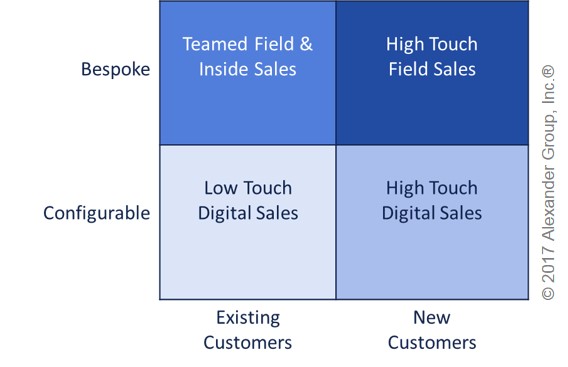European Leaders: Today’s B2B Buyer Journey Is ‘Business to Buyer’
It’s early October in central London. Over a dozen senior revenue leaders gather to discuss driving profitable growth in their respective companies. The highly diverse group represents technology, life sciences, manufacturing, media and services industries. Individuals around the table come from British, French, Italian, German, Indian and American origins. Yet the challenges and principles of driving B2B growth are universal:
“We need to figure out how to quickly route inbound calls to a more technical resource. Customers want this interaction.”
“If the solution is configurable, you can sell remotely. If it’s bespoke, it requires face to face.”
“How do we reach developers?”
“How do we cover developers? They don’t want to be sold to and need someone very technically gifted.”
The topic of discussion is Adapting Your Sales Model to the New Buyer Journey. According to Alexander Group research, today’s buyers are causing a radical shift in how companies cover the B2B market, or as one attendee re-phrased for the group, the “Business to Buyer” market. This subtle but important distinction emphasizes the importance of knowing the Customer (or Buyer) and not simply the Market.
The three-hour discussion focused on the latest sales trends and practices, covering three main topics: how to Access, Persuade, and Fulfill customers based on today’s buyer behavior.
Today’s buyers continue to push the boundaries on buying and selling via digital channels (phone and web). Every participant described efforts to advance the use of digital channels. Most/all have or are deploying live chat solutions to access and engage buyers.
Key Insight: Traditional lead generation methods are giving way to more “technically savvy” approaches. First responders must be able to address product inquiries with more technical knowledge or be able to quickly and easily escalate the call to a technically trained resource.
Persuading New and Existing Customers
As “land and expand” vernacular spreads, the question remains: What is the most effective means? Separate hunters and farmers or dedicated account executives? How far can sellers go with digital sales? One delegate shared, “Our biggest new logo signing this year came from the inside sales team.” Another noted, “We found a correlation between social selling index, skills and results,” indicating the growing importance of having sellers who can effectively leverage social tools like LinkedIn.
Key Insight: New buyers purchasing a bespoke solution require high-touch field sales. All others essentially lend themselves to either a blended, field/inside model or purely inside/digital sales model.

Key Insight: Certain geographies operate differently. Several delegates indicated how the Japanese market relies more heavily on in-person, face-to-face selling. Meanwhile markets like China and India are embracing digital channels quickly.
Fulfilling Customer Needs
As more companies across industries shift from selling “boxes” to selling “services,” the role of customer fulfillment (adoption, satisfaction and renewal) takes on new meaning and importance. Successfully executing the right service motion often leads directly to account expansion opportunities. The delegates agreed this is an area of increasing exploration and investment. Attendees shared:
“CSM isn’t a role; it’s a function. The question is how to best deliver it.”
“The number one issue for our CSM function is scale. How are we using technology and automation to support this function?”
“The role of marketing has changed. Everyone knows the core product. Marketing needs to focus on messaging for selling more to our existing customers.”
Key Insight: Delivering customer success is not simply deploying a CSM ‘job’; it requires careful coordination across sales, marketing and services.
Closing thought:
Adapting the sales model to the new buyer journey is more complicated than in the past. Many roles are moving inside, including lead gen, technical first responders, inside sales, product and technical specialists, and customer success. This is a model and structural shift for many companies accustomed to managing large field-deployed sales organizations.
Designing and executing the right go-to-customer model is a multi-dimensional problem. Marketing, sales and services need to execute against a common framework and operating model. This calls for bold and clear leadership. One Summit attendee captured the reality of this challenge:
“I like friction. It means we are creating, progressing and not standing still.”
Learn more about how Alexander Group’s Revenue Growth Model™ helps companies deliver profitable growth.
